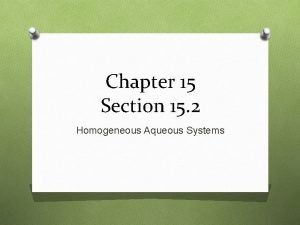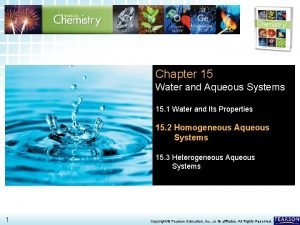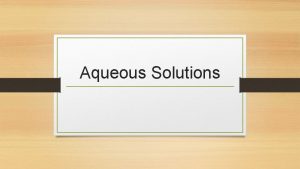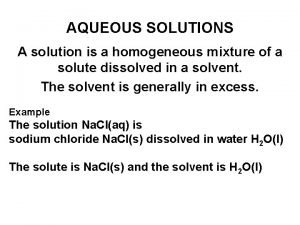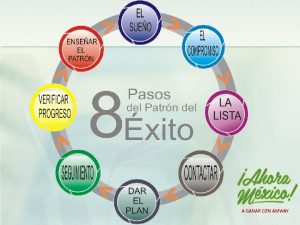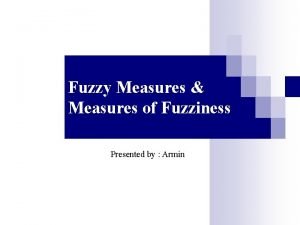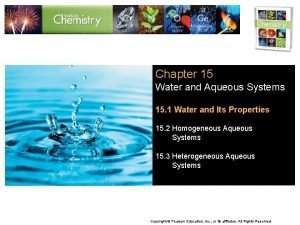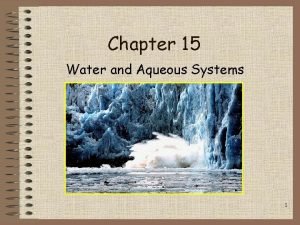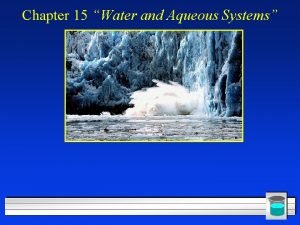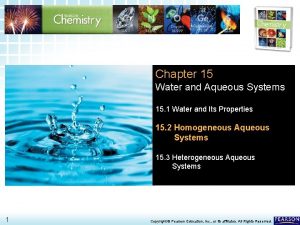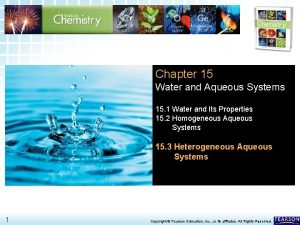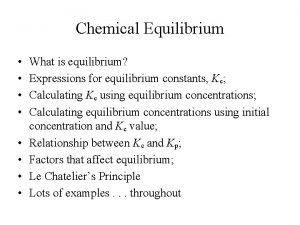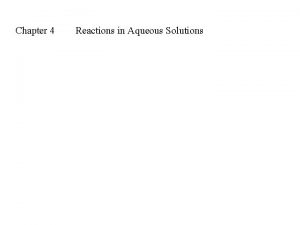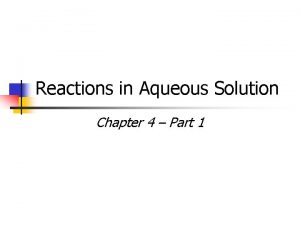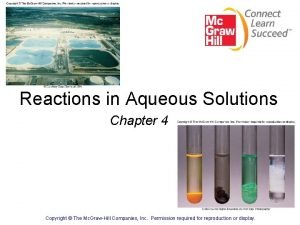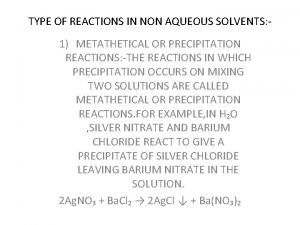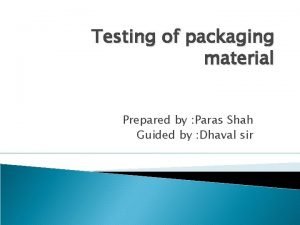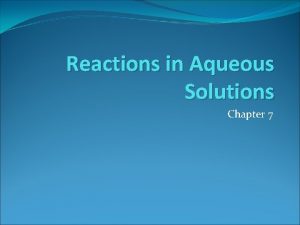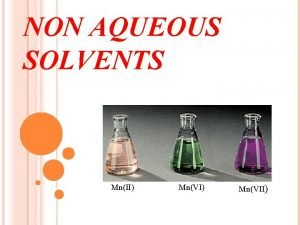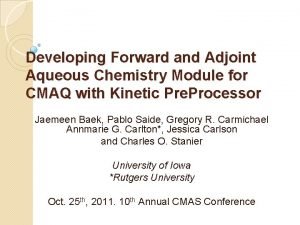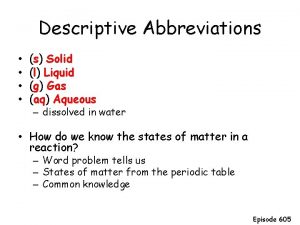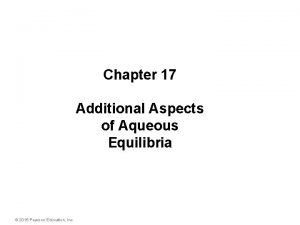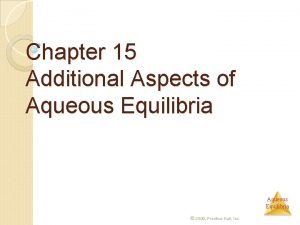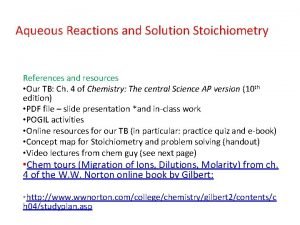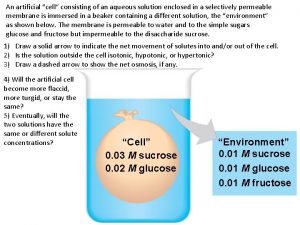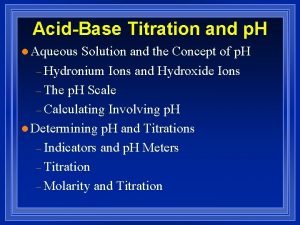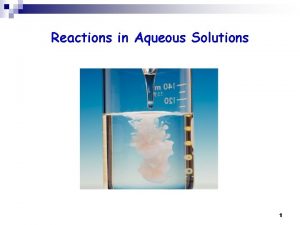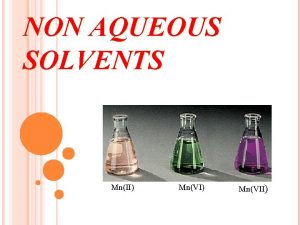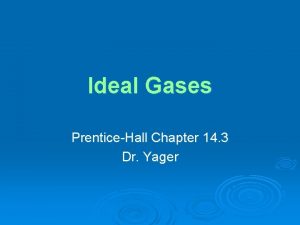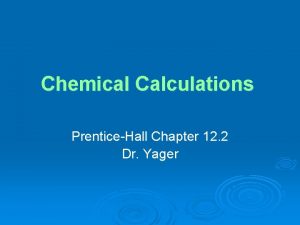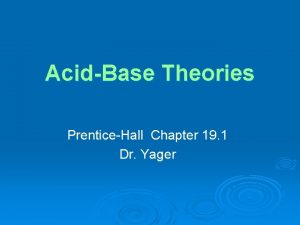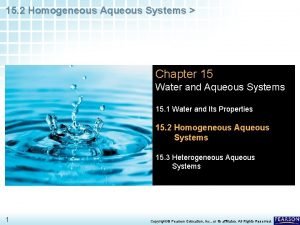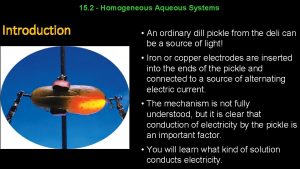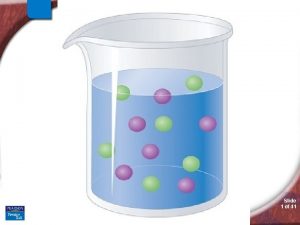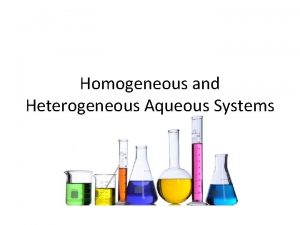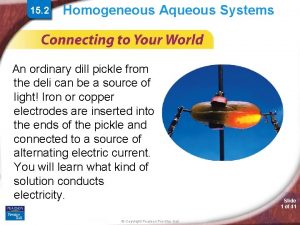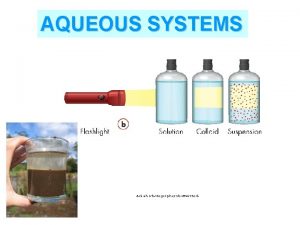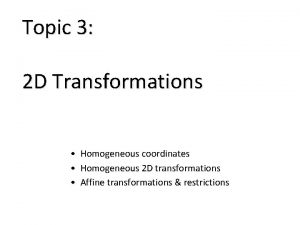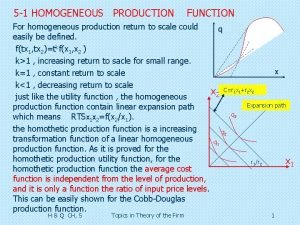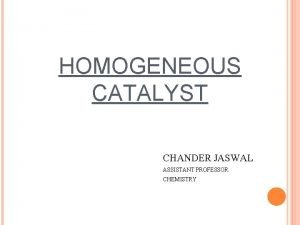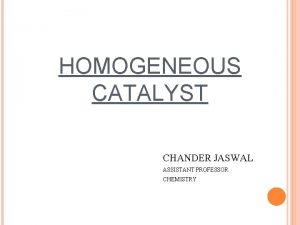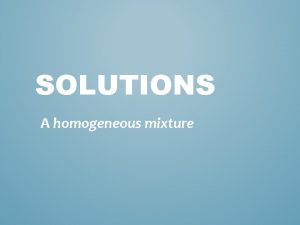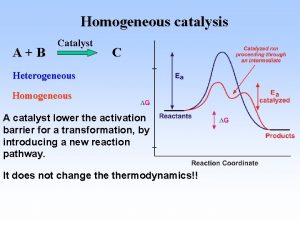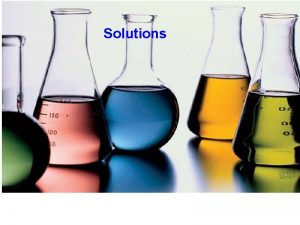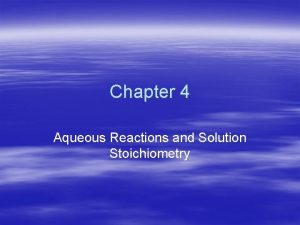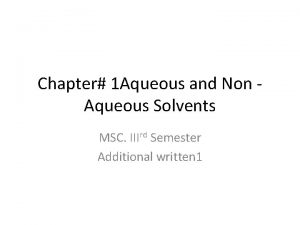Homogeneous Aqueous Systems Dr Yager PrenticeHall Chapter 15



































- Slides: 35

Homogeneous Aqueous Systems Dr. Yager Prentice-Hall Chapter 15. 2

Objectives v Identify the difference between a solute and a solvent. v Explain why all ionic compounds are electrolytes in solution. v Explain how to write a formula for a hydrate.

Homogeneous Aqueous Systems An ordinary dill pickle from the deli can be a source of light! Iron or copper electrodes are inserted into the ends of the pickle and connected to a source of alternating electric current. You will learn what kind of solution conducts electricity.

Solvent and Solute v An aqueous solution is water that contains dissolved substances. v In a solution, the dissolving medium is the solvent. v In a solution, the dissolved particles are the solute.

Solvent and Solute (cont) A solvent dissolves the solute. The solute becomes dispersed in the solvent. v Solvents and solutes may be gases, liquids, or solids. v Solute particles can be atoms, ions, or molecules.

Filtration If you filter a solution through filter paper, both the solute and the solvent pass through the filter.

What Happens? v As individual solute ions break away from the crystal, the negatively and positively charged ions become surrounded by solvent molecules, and the ionic crystal dissolves. v The process by which the positive and negative ions of an ionic solid become surrounded by solvent molecules is called solvation.

Solvation of an Ionic Solid

Polar vs Nonpolar Solvents v Polar solvents such as water dissolve ionic compounds and polar compounds. v Nonpolar solvents such as gasoline dissolve nonpolar compounds.

Oil and water do not mix.

Electrolytes & Nonelectrolytes v An electrolyte is a compound that conducts an electric current when it is in an aqueous solution or in the molten state. v All ionic compounds are electrolytes because they dissociate into ions.

The bright glow shows that sodium chloride is a strong electrolyte because nearly all the dissolved sodium chloride exists as separate Na+ and Cl– ions.

A weak electrolyte conducts electricity poorly because only a fraction of the solute in the solution exists as ions.

A compound that does not conduct an electric current in either aqueous solution or the molten state is called a nonelectrolyte.

Hydrates v Some compounds naturally contain water molecules that are embedded in their crystal structure, called water of hydration. v A compound that contains water of hydration is called a hydrate. v In writing the formula of a hydrate, use a dot to connect the formula of the compound and the number of water molecules per formula unit.

Hydrates (cont) v The forces holding water molecules in a hydrate are not very strong, making the water relatively easy to remove through heating. v A compound that contains no water of hydration is called an anhydrate. v The process of removing water from a compound is called dehydration.

A sample of blue Cu. SO 4· 5 H 2 O is heated.

Blue crystals of Cu. SO 4· 5 H 2 O crumble to a white anhydrous powder that has the formula Cu. SO 4.


Efflorescent Hydrates If a hydrate has a vapor pressure higher than the pressure of water vapor in the air, the hydrate will lose its water of hydration, or effloresce.

Hydroscopic Hydrates Hydrated salts that have a low vapor pressure remove water from moist air to form higher hydrates. These hydrates and other compounds that remove moisture from air are called hydroscopic.

When treated paper is exposed to moist air, it turns pink because of the formation of the hydrate cobalt(II) chloride hexahydrate (Co. Cl 2· 6 H 2 O).

Percent Water Calculation To determine what percent of a hydrate is water, first determine the mass of the number of moles of water in one mole of hydrate. Then determine the total mass of the hydrate. The percent mass of water can be calculated as:

Practice Problem

Deliquescent Hydrates v Deliquescent compounds remove sufficient water from the air to dissolve completely and form solutions. These compounds become wet when exposed to normally moist air.

The deliquescent substance, sodium hydroxide, absorbs moisture from air.

A solution forms.

1. Choose the correct words for the spaces. In any solution, the material that is dissolved is called the _____ and the material in which the substance is dissolved is called the _____. a. b. c. d. solid, liquid solvent, solute, solvent crystal, disperser

1. Choose the correct words for the spaces. In any solution, the material that is dissolved is called the _____ and the material in which the substance is dissolved is called the _____. a. b. c. solid, liquid solvent, solute, solvent d. crystal, disperser

2. In the solution process, the a. solvent molecules become dispersed in an ionic crystal. b. solvent molecules are surrounded by positive and negative ions. c. ions become emulsified in the solvent d. positive and negative ions are surrounded by solvent molecules.

2. In the solution process, the a. solvent molecules become dispersed in an ionic crystal. b. solvent molecules are surrounded by positive and negative ions. c. ions become emulsified in the solvent d. positive and negative ions are surrounded by solvent molecules.

3. All ionic compounds are electrolytes because they a. conduct electricity in the solid state. b. dissociate into ions in the aqueous and/or molten state. c. remain as positive-negative pairs even when dissolved. d. only conduct electricity in the molten state.

3. All ionic compounds are electrolytes because they a. conduct electricity in the solid state. b. dissociate into ions in the aqueous and/or molten state. c. remain as positive-negative pairs even when dissolved. d. only conduct electricity in the molten state.

4. The formula for iron(II) sulfate heptahydrate is a. Fe. SO 4(H 2 O)7 b. Fe. SO 4 • (H 2 O)7 c. Fe • 2 SO 4 • 7 H 2 O d. Fe. SO 4 • 7 H 2 O

4. The formula for iron(II) sulfate heptahydrate is a. Fe. SO 4(H 2 O)7 b. Fe. SO 4 • (H 2 O)7 c. Fe • 2 SO 4 • 7 H 2 O d. Fe. SO 4 • 7 H 2 O
 Do pickles conduct electricity
Do pickles conduct electricity Homogeneous aqueous systems
Homogeneous aqueous systems Are all aqueous solutions homogeneous
Are all aqueous solutions homogeneous Are aqueous solutions homogeneous mixtures
Are aqueous solutions homogeneous mixtures Definition of homogeneous differential equation
Definition of homogeneous differential equation Michalak and yager model
Michalak and yager model Plan de amway
Plan de amway Karen yager craft of writing
Karen yager craft of writing Yager
Yager Chapter 15 water and aqueous systems answer key
Chapter 15 water and aqueous systems answer key Water and aqueous systems chapter 15 answers
Water and aqueous systems chapter 15 answers Chapter 15 water and aqueous systems
Chapter 15 water and aqueous systems Chapter 15 water and aqueous systems
Chapter 15 water and aqueous systems Suspension vs solution
Suspension vs solution Hi
Hi Modern chemistry chapter 13 review answers
Modern chemistry chapter 13 review answers Chapter 4 reactions in aqueous solutions
Chapter 4 reactions in aqueous solutions Chapter 4 reactions in aqueous solutions
Chapter 4 reactions in aqueous solutions Chapter 4 reactions in aqueous solutions worksheet answers
Chapter 4 reactions in aqueous solutions worksheet answers Chapter 4 reactions in aqueous solutions
Chapter 4 reactions in aqueous solutions Types of reaction in non aqueous solvents
Types of reaction in non aqueous solvents For clarity of aqueous extract test container autoclaved at
For clarity of aqueous extract test container autoclaved at Reactions in aqueous solutions
Reactions in aqueous solutions Balancing redox reactions in acidic solution
Balancing redox reactions in acidic solution Reaksi anorganik dalam pelarut air dan non air
Reaksi anorganik dalam pelarut air dan non air What are protonic and non protonic solvents
What are protonic and non protonic solvents Aqueous solutions module
Aqueous solutions module Abbreviation for solid in chemistry
Abbreviation for solid in chemistry Additional aspects of aqueous equilibria
Additional aspects of aqueous equilibria Additional aspects of aqueous equilibria
Additional aspects of aqueous equilibria Aqueous reactions and solution stoichiometry
Aqueous reactions and solution stoichiometry An artificial cell consisting of an aqueous solution
An artificial cell consisting of an aqueous solution Aqueous acid base titration
Aqueous acid base titration Chemical reactions section 3 reactions in aqueous solutions
Chemical reactions section 3 reactions in aqueous solutions Is water aqueous
Is water aqueous Non aqueous solvent example
Non aqueous solvent example
